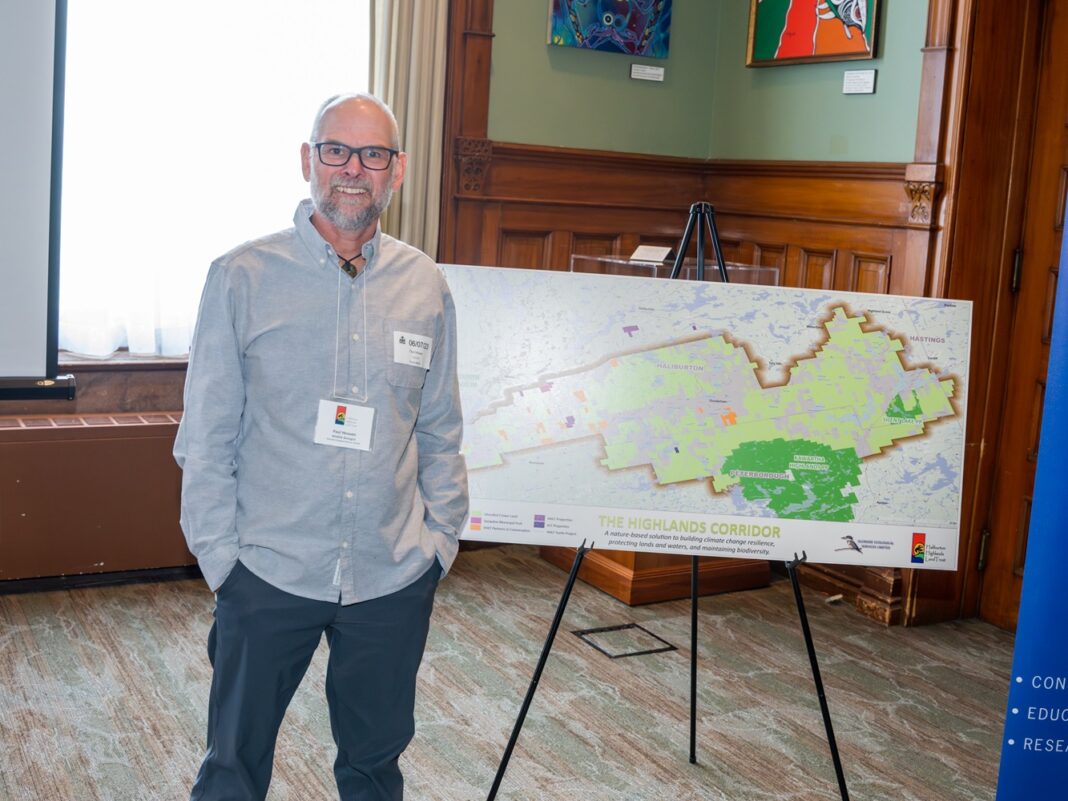The Haliburton Highlands Land Trust (HHLT) has responded to concerns about its Highlands Corridor initiative.
Late last week, some residents began writing letters to municipal, provincial and federal politicians – asking them to put a stop to the HHLT’s request for a conservation reserve.
The corridor is 100,000 hectares of Crown, municipal and private land from north of Norland in the west to Paudash Lake in the east; and south of Haliburton to Kawartha Highlands Provincial Park.
Wilberforce’s John Davidson said he was concerned the designation means people will no longer be able to hunt, fish, trap, use motorized vehicles, ride horses, camp, cycle, have unrestrained pets, fires, or use drones. He claimed the designation would also ban logging, mining and quarrying.
The Land Trust, on Feb. 10, responded to what it called “mistaken information” in the community.
The organization said the corridor is made up of private property, Crown land, and three provincial parks; Queen Elizabeth II Wildlands; Kawartha Highlands, and Silent Lake. However, it said only specific areas of Crown land would be designated ‘conservation reserve.’
It added that “within these potential conservation reserves, hunting, fishing, trapping, camping, ATV and dirt bike use on existing trails, horseback riding and cycling, pet walking, campfires etc. would continue to be permitted activities. Only logging, the development of new quarries, and mining would be prohibited in those sections.”
County council seeking more information
As for existing logging and quarry operations, they would be allowed to continue, the HHLT said.
The Land Trust added private property would not be impacted unless landowners wanted to voluntarily work with the HHLT.
It went on to elaborate on specifics in an open letter.
“Our ability to get out in nature – be it on foot, on skis, or ATV or dirt bike, to hunt or to fish is precisely what HHLT seeks to promote and protect through the establishment of conservation reserve spaces throughout the corridor. By designating these spaces as conservation reserves, we are safeguarding the health of these pristine forests and wetlands and ensuring the public’s enjoyment of them for generations to come.”
Conservation Reserve
Dennis Simmons, of Dennis C. Simmons Development and Land Management Consulting Services, in Irondale, is opposed to the corridor, with “even stronger” opposition to the Milburn Kendrick protected area. He said he owns land in the mapped area and his father, and grandfather, logged a large portion of the land and milled lumber.
“All of the land located within the proposed Haliburton Highlands Corridor, including the proposed Milburn Kendrick protected area, is not unique to the province of Ontario,” he argued. “I request the province leave well enough alone and cease this venture of the Haliburton Highlands Corridor and inclusive protected areas on Crown land.”
Simmons further told The Highlander the Ministry of Natural Resources should oversee Crown land, not the HHLT.
Les Selby has also written the province. “I feel they are overstepping their role in a negative way for future resource uses. Aggregates are required to build or resurface provincial and local roads, road sand and salt to protect us on winter roads, materials for developing housing, schools and hospitals, sand to cover municipal landfill sites during operations, etc.”
He added pits and quarries are a temporary land use, and are rehabilitated, with the MECP approving site plans.
Paul Heaven, of Glenside Ecological Services Limited, has been working with the Land Trust on the initiative. He, and the Land Trust’s Shelley Hunt, appeared before County Council Feb. 12 to further talk about their plans.
Addressing council questions, they clarified the only real change would see designation of 15 per cent of Crown land in the Milburn Kendrick protected area. Heaven added the Bancroft Minden Forest Company, which holds the licence, has agreed with the Land Trust that the ecological value of the land outweighs the forestry value.
The two added the Trust is working with the Ontario Federation of Anglers and Hunters, and more recently, the Ontario Trails Protection Alliance.
Speaking specifically to the Milburn Kendrick, Heaven said it is “rich in ecological value, and provides excellent recreational resources.” He added it boasts 24 per cent wetlands, which tackle climate change via flood mitigation, and capturing and storing carbon.
He said it supports five provincially-significant wetland complexes, including the Milburn, Bark Creek, Kendrick Creek, Lochlin, and South Milburn wetland complexes, and that the Lochlin Bog is significant.
Heaven added it supports a mix of habitats, including forests, wetlands, rocky barrens and 55 rare and/or at-risk species.
“It is for these exceptional ecological values that the HHLT is proposing the area be designated as a conservation reserve: a designation that permanently protects ecosystems, biodiversity and provincially-significant elements while providing recreational opportunities.”
Following Wednesday’s meeting, County council intends to seek more information, including from the related provincial ministries, and discuss the issue further at its March 26 meeting.





